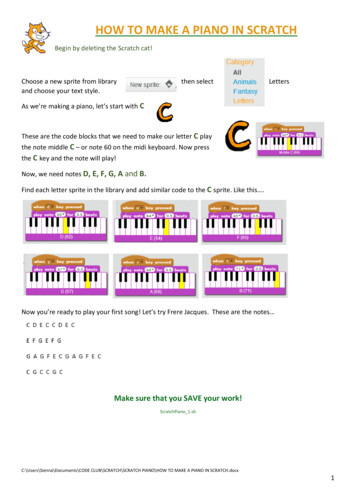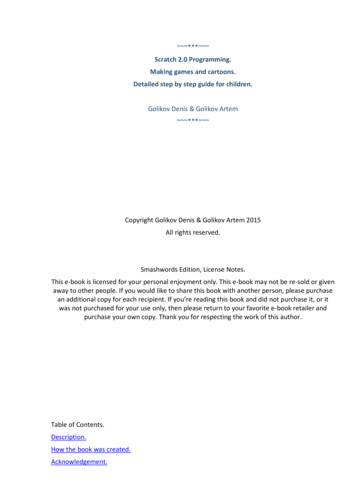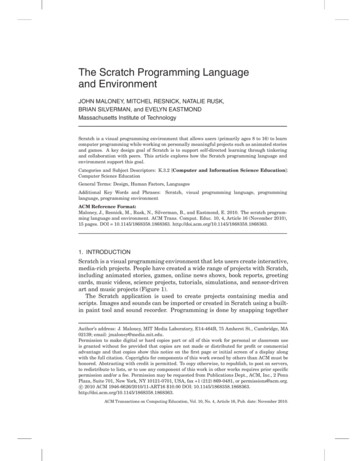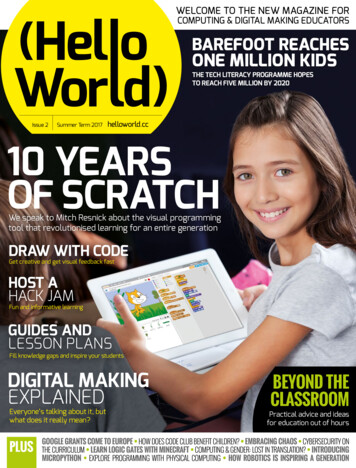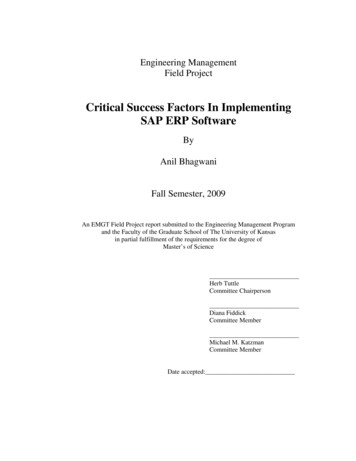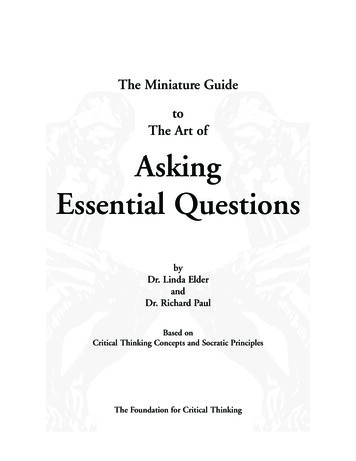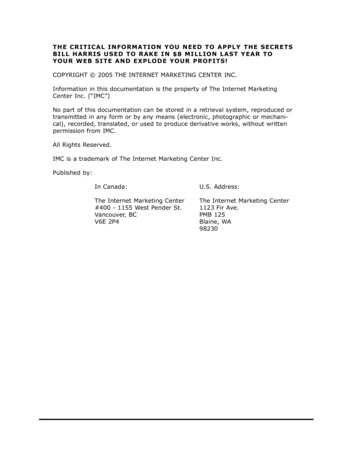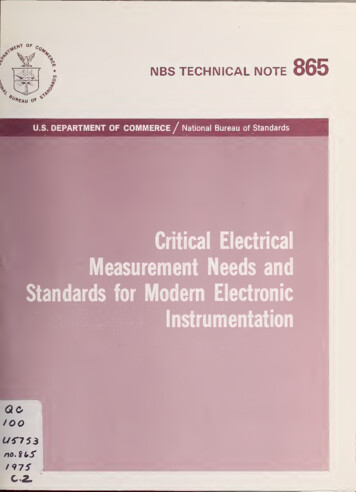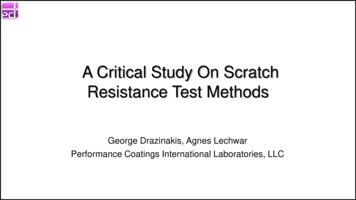
Transcription
A Critical Study On ScratchResistance Test MethodsGeorge Drazinakis, Agnes LechwarPerformance Coatings International Laboratories, LLC
Scratch Resistance Test Methods How do we evaluate thin-film UV-curable coatings’ abrasion resistanceproperties? Which ASTM wear or other International Standard Test provides quick, accurateand relevant results that correlate well with field use or experience? How do companies report test data with various scratch, abrasion wear methods? How do we rate and select thin-film coatings to use for our products? Does higher crosslinking density and higher functionality necessarily improveabrasion resistance?
Scratch Resistance Test Methods The identification and characterization of surface wear in plastics, is paramount in ProductPerformance, critical to Quality and invaluable for Manufacturing operations. Scratches in optical clear plastics used in electronic touchscreens, portable instruments,displays and many opto-electronic devices are created by different abrasion modes thanmechanical components in constant contact, under cyclic load. Physical damage due to scratches changes the substrate’s morphology, productappearance causing optical changes in gloss, color and reflected image’s focused quality. All plastic displays, lenses, etc. will eventually wear; scratches affect durability and lead topremature failure. One of the critical features for a Good Laboratory Test (in R&D and QC) is that findingsand conclusions correlate well with product’s actual use in predicting real failure modes;which can only be verified by field testing!
Scratch Resistant Test MethodsWear MechanismsAbrasionAdhesionCavitationCorrosionWear is damage done to a surface (removal of material,)based on the movement of asperities between two bodies inrelative motion, under load. Wear is a complex phenomenonand various wear mechanisms above cause “Industrial” wear.The concepts of friction and impact are critical to understandand predict wear.Fatigue
Scratch Resistance Test Methods The frictional force resisting movement of objects in relative motion, does not depend oncontact area but on the gravitational, normal force. Every smooth surface at the nano level is “rough”; thus, materials in contact only touchover small “peaks,” called asperities. These asperities in contact reach stability(equilibrium) by elastic and plastic deformation. The Archard wear equation is a simple model used to describe the sliding abrasionwear, based upon the theory of asperity contact:Q KWL/HWhere:Q total volume of wear material removedW normal load (gravitational force)L sliding distanceK dimensionless constant, for severity of wearH hardness of the softest of the contacting surfaces
Scratch Resistant Test MethodsAbrasion WearScratch abrasion is a surface deformation process; is caused by indentation (on a surface) due tothe displacement and removal of material , under load, over a period of time by another harderobject.Most thermoplastics due to their viscoelastic properties, do not follow the classical laws of friction(non-linear relationship between contact pressure, sliding speed and coefficient of friction) becauseof the large plastic deformation that occurs at the tips of the asperities.
Scratch Resistant Test MethodsExperimental Foundations Mechanical properties of UV-cured resins strongly depend on the effective chainlength between cross-links. A high network density is thus necessary for superior mechanical properties andchemical resistance. However, higher flexibility is achieved with non highly crosslinked coatings. The functionality and concentration of reactive thinners and diluents have asignificant influence on hardness and elasticity in the UV curable, thin film coatings. Two UV-curable, multi-functional acrylate coatings (one moderately hard and oneextra hard) w/o nanoparticles were tested on PC and PMMA substrates, at dry filmthickness of 7µm and 13 µm.
Scratch Resistant Test MethodsCoatingsCoating 1Coating 1Coating 1Coating 1Coating 2Coating 2Coating 2Coating 2MaterialDry-Film ThicknessPCPCPMMAPMMAPCPCPMMAPMMADesignated7 microns13 microns7 microns13 microns7 microns13 microns7 microns13 2,2,2Materials Tested:Polycarbonate (PC) – Lexan 9034 from SABIC Innovative Plastics IP BV.Acrylic (PMMA) – Optix from Plaskolite, Inc.Material PropertiesPropertiesPC - Lexan 9034Test MethodUnitMfgPMMA -OPTIXPCI LabsMfgPCI LabsInitial HazeASTM D1003% 10.1820.1Taber @ 100 cyclesASTM D1044% haze1034.9 (500 g)24.237.61 (500 g)Pencil HardnessASTM D3363NR3BNRHSheet ThicknessMicrometer1.51.51.51.5mm
Scratch Resistance Test MethodsProcess Conditions Spray System: Fully automatic w/ air pressure pod, HVLP gun (w/ 1mm tip) . Convection Oven (w/ air circulation): 3 minutes @ 30 C UV: 460 mJ/cm2 (1.36 W/cm2) @ 127 mm/s (25 fpm) – with UV Fusion H lamps QC: Cross-Cut Adhesion Check - ISO Class: 0 / ASTM Class: 5B - (ISO 2409, ASTMD3002) Conditioned Samples: Prepared per ASTM – D618-95 Samples Tested: 30 per test, with a 90% confidence interval (ɑ/2 0.05)
Scratch Resistant Test MethodsRotary Steel Wool Tester
Scratch Resistant Test MethodsRotary Steel Wool Test Methods - MeasurementsSteel Wool Ratio Δcoat / Δsub (1)Steel Wool Ratio Δcoat / Δstd (2)Δ coat final haze value of test sample – initial haze value of sameΔ sub final haze value of uncoated substrate – initial haze value of substrateΔ std final haze value of standard coating – initial haze value of standard coatingThe Rotary Steel wool test is applicable to: Rank optically clear coatings; same dry-film thickness on same substrate material Rank different optically clear materials; same coating (same dry-film thickness) on differentsubstrates. Rank competitive coatings Vs. benchmark coating of same thickness
Scratch Resistant Test MethodsRotary Steel Wool Tester The Steel Wool Tester is one of the few abrasion tests that the test loads can be large 345 Kpa and can simulate “real-life” damage. It is a quick and easy method that provides both qualitative and quantitative QC data. The Rotary Steel Wool Tester with a constant angular velocity (ω), creates both variedtangential velocities (ωr) and centripetal acceleration (ω2 r) components that impact thinfilm coatings, dramatically. If the most prevalent mode of failure is scratching, the use of steel wool as an abrasivemedium is well suited to quickly generate scratches on the surface of a material incurvilinear motion. The preparation of the standardized steel wool pad (by the same manufacturer,) by foldingand with proper fiber orientation is critical for measurement. Furthermore, conditioning ofthe pads for 250 cycles is necessary for consistent results.
Scratch Resistant Test Methods“RCA” Abrader – Norman Tool Tester(ASTM F-2357)
Scratch Resistant Test Methods“RCA” Abrader – Norman Tool Test Method The RCA test is influenced by humidity and age of paper, required for testing. Newpaper from the same source without wax, must be used. For the RCA Test, temperature and humidity play an important role and must bereported; as well as, how the tested material and tape used were conditioned! RCA wear tests are significantly influenced by coating thickness and substratematerial’s hardness; PMMA performed better than PC. With both coatings tested it performed better @ higher dry film thickness. Higher functionality UV-cured coatings faired better than lower functionality. Temperature rise due to frictional heating with the corresponding change in thecoefficient of friction, has an effect on the results of the test.
Scratch Resistant Test MethodsPencil Hardness TesterWolf-Wilburn Method(ASTM-D-3363)
Scratch Resistant Test MethodsFs µ x Fn (gravitational force)µ coefficient of frictionOrdinary friction is arising fromsurface roughness Friction due to the movement of asperities on a material’s surface incontact with another harder material, causes wear. Plastics in particular, with their wide range of plastic deformation have acoefficient of friction that is generally lower than other harder materials,under the same load conditions.
Scratch Resistant Test MethodsTest ResultsPencil Hardness Evaluation ,1C2,1,2C2,2,1ASTM D33633BHHBHB2H4HHHB 6H 2H7H7H2H2H2B3HFH6H6HFF2BHHBF6H6HHHStaedtler Mars - Lumograph 100, Staedtler Mars, GmbH & Co., GermanyFaber-Castel - Graphite Sketch Set, Faber-Castell, GermanyDerwent - Graphic Arts, Acco Ltd, UKSanford - Prismacolor Premier - Sanford, LP., USAArtist's Loft - Sketching Pencils (ASTM D-4236) - ThailandMitsu-Bishi - Hi Uni , Mitsu-Bishi, Japan7H8H9H8H8H6H8H8H9H8H9H7HMfg 1Mfg 2Mfg 3Mfg 4Mfg 5Mfg 6Manufacturer 1Manufacturer 2Manufacturer 3Manufacturer 4Manufacturer 5Manufacturer 6C2,2,2
Scratch Resistant Test MethodsOn Pencil Hardness There is variation between pencil manufactures in graphite, clay and binder composition. There is variation in pencil hardness on the same coating and material, by different pencilmanufactures. There is inconsistency within pencils (fail at 2H while passing 3H @ 5H). The substrate materials Rockwell hardness (M-scale) significantly influences a coatingspencil hardness measurement. Must report test load, pencil manufacturer, speed of slide and coating thickness, forrelevant comparisons on same substrate material between thin film coatings. Proper conditioning of pencil lead is important, as per ASTM.
Scratch Resistant Test MethodsTaber Wear Tester(ASTM D-1044)
Scratch Resistant Test MethodsTaber Abrader Test Method Can’t use the Wear Index ( weight loss method ASTM - 4060) in thin film coatings. Measure the percent change in haze value (final – initial haze.)Haze of a specimen is defined as the percentage of transmitted light, which inpassing through the specimen deviates more than 2.5⁰ from the incident beam byforward scattering. Taber Abrader test instrument requires regular calibration to ensure accurateresults. There is variability of Lab results based on test process; running continuously longcycles vs. stopping at regular intervals, cleaning abraser media from the substratesurface and continuing with the test . Temperature rise due to frictional heating with the corresponding change in thecoefficient of friction, has an effect on the results of the test.
Scratch Resistant Test MethodsTest ResultsAbrasion Resistance Wear TestsC1,1,1TestUnitsTaber (2)%ΔHaze"RCA" (3)CyclesPencil (4)#Steel Wool(5)kPa(psi)Steel Wool(6)(1)(2)(3)(4)(5)(6)(7)Coatings (1)C1,2,2C2,1,1C1,1,2C1,2,1PC7µm8.4PC13 76(40)262(38)345(50)345(50) 345(50) 345(50)0.120.130.240.220.110.12See Designation under Materials.ASTM 1044-99, Taber Calibrase CF-10F @ 500g and100 cyclesASTM F 2357-04, Norman Tool PaperMitsu- Bishi, Hi-Uni PencilsRhodes American, Super Fine #0000 steel wool, 25 rotations (1rps) @ load (4 cm2 )Steel Wool Ratio – Formula (2)Temperature 21.5 C /- 1 ºC (70.7 F) & Relative Humidity of 52% /- 3%(**) The number of coated samples tested were 30, per test, with a 90% confidence interval (ɑ/2 0.05).
Scratch Resistance Test MethodsConclusionsThe RCA wear test is significantly influenced by coating thickness and substrate material’shardness. PMMA performed better than PC and both coatings performed better at higher dry filmthickness.In the Taber wear test the higher cross-linked coating performed better and the coating thicknesshad a positive effect. PC at the higher dry film thickness performed better.There is a minor difference in pencil hardness with increased coating thickness in thin films.However, there was a substantial difference based upon the substrate’s material hardness itself.PMMA performed much better.The Steel Wool test verified better performance vs. higher crosslinking density. The bestperformer was PC at the smaller dry-film thickness.
Scratch Resistant Test MethodsScratch Test Methods EvaluationSubstrate Hardness(Rockwell)Film ThicknessCrosslink DensityCoating DifferentiatorTaber Wear AverageRCA Abrader AveragePencil Average BetterScratch TestRotary Steel Wool
Scratch Resistance Test MethodsConclusions The same coating with the same dry film thickness, will behave different on different substratematerials and that includes topcoats on different basecoats, used in a multi-layer systems. The overall scratch resistance is improved by the increased functionality of the acrylate basedresins in thin film UV-curable coatings. The wear tests performed provide insight into how inconsistent test results can be within the antiscratch coatings industry, when test methods and conditions vary. A number of different conclusions can be drawn from the data reported above, comparing differentabrasion resistance test methods. Coatings evaluations must be performed on the same material, at the same dry film thickness withthe same abrasive media, properly conditioned, to demonstrate clear statistical differences for thinfilm UV-curable coatings and provide reliable acceptance criteria.
Scratch Resistance Test MethodsConclusions Scratch abrasion is complex mechanical damage process; test method dependent. Slip additives, fluorocarbons, solid lubricants (PTFE, etc.) with their extreme low coefficient offriction, have a positive effect on scratch wear tests. The type of abrasion wear (in movement and force) must be carefully analyzed regardingcycling, repeatability, randomness, constancy, etc. For example, most (coated) displays faildue to scratches caused by sharp objects and moderate load, rather than repetitive orconstant loading. The rotary steel wool test is a quick test that provides better correlation with abrasion wearwhen the load is not cycling
Pencil Hardness ASTM D3363 NR 3B NR H Sheet Thickness Micrometer mm 1.5 1.5 1.5 1.5. Scratch Resistance Test Methods Process Conditions Spray System: Fully automatic w/ air pressure pod, HVLP gun (w/ 1mm tip) . Convection Oven (w/ air circulation): 3 minutes @ 30 C UV: 460 mJ/cm2 (1.36 W/cm2) @ 127 mm/s (25 fpm) –with UV Fusion H lamps QC: Cross-Cut Adhesion Check - ISO .
